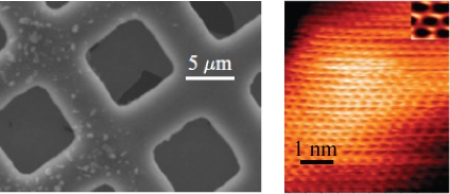A team of researchers from the University of Arkansas and Nanjing University has developed a new experimental technique to control the strain or mechanical property of freestanding graphene sheets suspended over small square meshes of copper.
 Left, an atomic force microscope image of the suspended graphene membrane on the copper mesh. On the right, a scanning tunneling microscope image with atomic resolution taken on the suspended graphene membrane. The researchers were able to use the scanning tunneling microscope to control the shape, and therefore the electronic properties, of the graphene membrane. (Image courtesy of Salvador Barazzo-Lopez, University of Arkansas)
Left, an atomic force microscope image of the suspended graphene membrane on the copper mesh. On the right, a scanning tunneling microscope image with atomic resolution taken on the suspended graphene membrane. The researchers were able to use the scanning tunneling microscope to control the shape, and therefore the electronic properties, of the graphene membrane. (Image courtesy of Salvador Barazzo-Lopez, University of Arkansas)
When strain is induced on freestanding graphene, it acts as if it is under the influence of a magnetic field. The research team is also able to manipulate other important properties such as the electronic properties of this nanomaterial by controlling the strain.
During the study, Paul Thibado’s team and Peng Xu from the University of Arkansas used a scanning tunneling microscope (STM) to investigate the surface of graphene membranes suspended over the meshes of copper under a constant current condition. The researchers altered the voltage to maintain the constant current as the STM tip tends to move. This up and down movement of the tip changes the shape of the freestanding graphene membranes.
The researchers found that the electric charge between the graphene membrane and the tip controlled the shape and position of the membrane. Hence, they were able to control the strain on the graphene membrane by altering the tip voltage. This control is critical to manipulate the nanomaterial’s pseudo-magnetic properties.
As part of the study, Laurent Bellaiche and Salvador Barraza-Lopez from the University of Arkansas together with Yurong Yang from the Nanjing University and University of Arkansas have studied graphene membrane-based theoretical systems to analyze this newly discovered ability to manipulate the strain generated by the new technique.
The researchers validated the level of strain on the theoretical systems and modeled the STM tip position with respect to the membrane. They found that the interaction between the tip and the graphene membrane relied on the tip’s position on the membrane. These findings will be helpful in computing the pseudo-magnetic field for a specific strain and voltage.
The researchers also discovered that the frontiers formed by the copper mesh made the pseudo-magnetic field to oscillate between negative and positive values, thus enabling scientists to report an optimum value for the field rather than a constant value. Barraza-Lopez informed that if the meshes are triangular, then the fields may become non-oscillating fields, thus paving the way to use the nanomaterial’s pseudo-magnetic property in a more controlled manner.
The study findings have been reported in Physical Review B Rapid Communications.